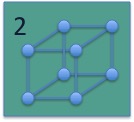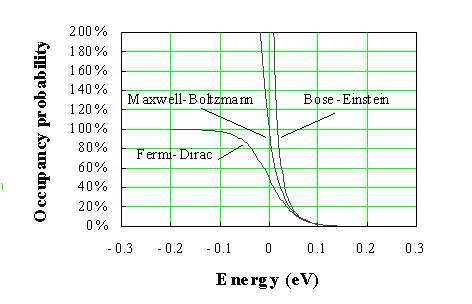


The distribution or probability density functions describe the probability that particles occupy the available energy levels in a given system. Of particular interest is the probability density function of electrons, called the Fermi function. The derivation of such probability density functions can be found in one of the many statistical thermodynamics references |
2.5.1 Fermi-Dirac distribution function |      |
The Fermi-Dirac distribution function, also called Fermi function, provides the probability of occupancy of energy levels by Fermions. Fermions are half-integer spin particles, which obey the Pauli exclusion principle. The Pauli exclusion principle postulates that only one Fermion can occupy a single quantum state. Therefore, as Fermions are added to an energy band, they will fill the available states in an energy band just like water fills a bucket. The states with the lowest energy are filled first, followed by the next higher ones. At absolute zero temperature (T = 0 K), the energy levels are all filled up to a maximum energy, which we call the Fermi level. No states above the Fermi level are filled. At higher temperature, one finds that the transition between completely filled states and completely empty states is gradual rather than abrupt. |
Electrons are Fermions. Therefore, the Fermi function provides the probability that an energy level at energy, E, in thermal equilibrium with a large system, is occupied by an electron. The system is characterized by its temperature, T, and its Fermi energy, EF. The Fermi function is given by: |
 | (2.5.1) |
This function is plotted in Figure 2.5.1 at 150, 300 and 600 K. |
 |
| Figure 2.5.1 : | The Fermi function at three different temperatures.  |
The Fermi function has a value of one for energies, which are more than a few times kT below the Fermi energy. It equals 1/2 if the energy equals the Fermi energy and decreases exponentially for energies which are a few times kT larger than the Fermi energy. While at T = 0 K the Fermi function equals a step function, the transition is more gradual at finite temperatures and more so at higher temperatures. |
2.5.2 Example |      |
To better understand the origin of distribution functions, we now consider a specific system with equidistant energy levels at 0.5, 1.5, 2.5, 3.5, 4.5, 5.5, .... eV. Each energy level can contain two electrons. Since electrons are indistinguishable from each other, no more than two electrons (with opposite spin) can occupy a given energy level. This system contains 20 electrons. |
The minimum energy of this system corresponds to the situation where all 20 electrons occupy the ten lowest energy levels without placing more than 2 in any given level. This situation occurs at T = 0 K and the total energy equals 100 eV. |
Since we are interested in a situation where the temperature is not zero, we arbitrarily set the total energy at 106 eV, which is 6 eV more than the minimum possible energy of this system. This ensures that the thermal energy is not zero so that the system must be at a non-zero temperature. |
There are 24 possible and different configurations, which satisfy these particular constraints. Eight of those configurations are shown in Figure 2.5.2, where the filled circles represent the electrons: |
 |
| Figure 2.5.2 : | Eight of the 24 possible configurations in which 20 electrons can be placed having a total energy of 106 eV. |
We now apply the basic postulate of statistical thermodynamics, namely that all possible configurations are equally likely to occur. The expected configuration therefore equals the average occupancy of all possible configurations. |
The average occupancy of each energy level taken over all (and equally probable) 24 configurations is compared in Figure 2.5.3 to the Fermi-Dirac distribution function. A best fit was obtained using a Fermi energy of 9.998 eV and kT = 1.447 eV or T = 16,800 K. The agreement is surprisingly good considering the small size of this system. |
 |
| Figure 2.5.3 : | Probability versus energy averaged over the 24 possible configurations (circles) fitted with a Fermi-Dirac function (solid line) using kT = 1.447 eV and EF = 9.998 eV.  |
Based on the construction of the distribution function in this example, one would expect the distribution function to be dependent on the density of states. This is the case for small systems. However, for large systems and for a single energy level in thermal equilibrium with a larger system, the distribution function no longer depends on the density of states. This is very fortunate, since it dramatically simplifies the carrier density calculations. One should also keep in mind that the Fermi energy for a particular system as obtained in section 2.6 does depend on the density of states. |
2.5.3 Impurity distribution functions |      |
The distribution function of impurities, as introduced in section 2.6.4, differs from the Fermi-Dirac distribution function even though the particles involved are still Fermions. The difference is due to the fact that an ionized donor energy level still contains one electron with either spin. The donor energy level cannot be empty since this would leave a doubly positively charged atom, which would have an energy different from that of the singly ionized donor level. The distribution function for donors therefore differs from the Fermi function and is given by: |
 | (2.5.2) |
The distribution function for acceptors differs also because of the different possible ways to occupy the acceptor level. The neutral acceptor contains no electrons. The ionized acceptor contains one electron, which can have either spin, while the doubly negatively charged state is not allowed since this would require a different energy. This restriction would yield a factor of 2 in front of the exponential term. In addition, one finds that most commonly used semiconductors have a two-fold degenerate valence band, which causes this factor to increase to four, yielding: |
 | (2.5.3) |
2.5.4 Other distribution functions and comparison |      |
Other distribution functions include the Bose-Einstein distribution and the Maxwell-Boltzmann distribution. These are briefly discussed below and compared to the Fermi-Dirac distribution function. |
The Bose-Einstein distribution function applies to bosons. Bosons are particles with integer spin and include photons, phonons and a large number of atoms. Bosons do not obey the Pauli exclusion principle so that any number can occupy a single energy level. The Bose-Einstein distribution function is given by: |
 | (2.5.4) |
This function is only defined for E > EF. |
The Maxwell Boltzmann applies to non-interacting particles, which can be distinguished from each other. This distribution function is also called the classical distribution function since it provides the probability of occupancy for non-interacting particles at low densities. Atoms in an ideal gas form a typical example of such particles. The Maxwell-Boltzmann distribution function is given by: |
 | (2.5.5) |
A plot of the three distribution functions, the Fermi-Dirac distribution, the Maxwell-Boltzmann distribution and the Bose-Einstein distribution is shown in Figure 2.5.4. |
 |
| Figure 2.5.4 : | Probability of occupancy versus energy of the Fermi-Dirac, the Bose-Einstein and the Maxwell-Boltzmann distribution. The Fermi energy, EF, is assumed to be zero.  |
All three functions are almost equal for large energies (more than a few kT beyond the Fermi energy). The Fermi-Dirac distribution reaches a maximum of 100% for energies, which are a few kT below the Fermi energy, while the Bose-Einstein distribution diverges at the Fermi energy and has no validity for energies below the Fermi energy. |
2.5.5 Derivation of the Fermi-Dirac distribution function |      |
To derive the Fermi-Dirac distribution function, we start from a series of possible energies, labeled Ei. At each energy, we can have gi possible states and the number of states that are occupied equals gifi, where fi is the probability of occupying a state at energy Ei. We also assume that the number of possible states is very large, so that the discrete nature of the states can be ignored. |
The number of possible ways - called configurations - to fit gi fi electrons in gi states, given the restriction that only one electron can occupy each state, equals: |
 | (2.5.6) |
This equation is obtained by numbering the individual states and exchanging the states rather than the electrons. This yields a total number of gi! possible configurations. However since the empty states are all identical, we need to divide by the number of permutations between the empty states, as all permutations cannot be distinguished from each other and can therefore only be counted once. In addition, all the filled states are indistinguishable from each other, so we need to divide also by all permutations between the filled states, namely gifi!. |
The number of possible ways to fit the electrons in the number of available states is called the multiplicity function. |
The multiplicity function for the whole system is the product of the multiplicity functions for each energy EI: |
 | (2.5.7) |
Using Stirling’s approximation, one can eliminate the factorial signs, yielding: |
 | (2.5.8) |
The total number of electrons in the system equals N and the total energy of those N electrons equals U. These system parameters are related to the number of states at each energy, gi, and the probability of occupancy of each state, fi, by: |
 | (2.5.9) |
and |
 | (2.5.10) |
According to the basic assumption of statistical thermodynamics, all possible configurations are equally probable. The multiplicity function provides the number of configurations for a specific set of occupancy probabilities, fi. The multiplicity function sharply peaks at the thermal equilibrium distribution since this is the most likely distribution of the system and must therefore be associated with the largest number of - equally probable - configurations. The occupancy probability in thermal equilibrium is therefore obtained by finding the maximum of the multiplicity function, W, while keeping the total energy and the number of electrons constant. |
For convenience, we maximize the logarithm of the multiplicity function instead of the multiplicity function itself. According to the Lagrange method of undetermined multipliers, we must maximize the following function: |
 | (2.5.11) |
where a and b need to be determined. The maximum of the multiplicity function, W, is obtained from: |
 | (2.5.12) |
which can be solved, yielding: |
 | (2.5.13) |
or |
 | (2.5.14) |
which can be written in the following form |
 | (2.5.15) |
with β = 1/b and EF = -a/b. The symbol EF was chosen since this constant has units of energy and will be the constant associated with this probability distribution. |
Taking the derivative of the total energy, one obtains: |
 | (2.5.16) |
Using the Lagrange equation, this can be rewritten as: |
 | (2.5.17) |
Any variation of the energies, EI, can only be caused by a change in volume, so that the middle term can be linked to a volume variation dV. |
 | (2.5.18) |
Comparing this to the thermodynamic identity: |
 | (2.5.19) |
one finds that β = kT and S = k lnW, where k is a constant that must be determined . The energy, EF, equals the energy associated with the particles, namely the electro-chemical potential, μ. |
The comparison also identifies the entropy, S, as being proportional to the logarithm of the multiplicity function, W. The proportionality constant, k, is known as Boltzmann’s constant. |
The Fermi-Dirac distribution function then becomes: |
 | (2.5.20) |
Note that this derivation can only truly be followed if one has prior knowledge of statistical thermodynamics. Those who are well versed in this field can quickly derive the Fermi-Dirac and other distribution functions using the Gibbs sum. A more complete description can be found in: Thermal Physics, second edition, C. Kittel and H. Kroemer, Freeman, 1980. |
| Boulder, 2022 |